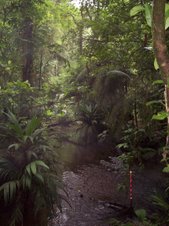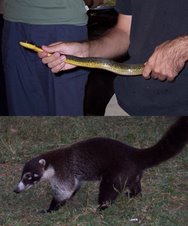After speaking with Mike Guill re: Bayesian stats earlier this week, I've decided to change my independent project. I'm really interested in learning more about Bayesian analysis - I like the philosophical concepts behind the techniques (directly testing the hypothesis rather than the data, using prior information to come to a conclusion). I'm curious to see for myself how the analysis works (I can't really fully understand a technique like this until I've done it myself), and just how influential informative priors are on the outcomes. So, rather than analyze Tom's dataset of niche breadths for competitive exclusion, I'm going to revisit an old dataset of mine comparing arthropod abundance and defenses and avian insectivore foraging success in two Costa Rican forests.
This data was collected to test one component of an avian life-history theory which my lab has been working on. Birds - like many other organisms - have a distinct latitudinal gradient in demographic rates (most notably clutch size, but also survival et al.) wherein tropical birds have "slow" life-histories (low reproduction, high survival, low metabolic rates) and temperate birds have "fast" life-histories (high reproduction, low survival, high metabolic rates). Hypotheses have been proposed to explain this since the early 1900s, but none fully explain the observed patterns.
We suspect that food limitation is at the root of this gradient. Specifically, we cite references showing that tropical insectivorous birds face strong food limitation - contrary to popular belief - due to the low seasonality (lack of a seasonal "flush" of resources), low population densities of arthropods, and strong predator pressure (due to many species of insectivorous birds feeding on arthropod prey) leading to development of strong anti-predator defenses (physical, chemical, and behavioral) by arthropods. These forces should be strongest in so-called "perhumid" moist tropical rainforests with limited seasonality, moderate in dry-seasonal tropical forests, and weakest in temperate areas.
I sought to test this by comparing arthropod population densities and defenses in a moist tropical forest (La Selva, go figure) and a dry-seasonal forest (Palo Verde), both in Costa Rica. I also observed insectivorous birds and recorded various measures of foraging success & movement rates. I originally analyzed this data using univariate parametric and non-parametric statistics (t-tests, ANOVA, Chi-square, Kolmogorov-Smirnov) and also ran it through a multivariate MANOVA, but found few significant results.
I'm very curious to see if Bayesian analysis will produce similar results. I also have several references upon which I based my hypotheses from which I can draw data for prior distributions, and I want to test the influence of several different informative and non-informative priors.
Subscribe to:
Post Comments (Atom)




1 comment:
Hey Nicole, sorry I didn't commment earlier but I am just discovering this post. This sounds like a great idea. The research seems fascinating. Did your data not show significant results between different life histories and insect populations or between insect populations and dry or wet forest? Also, I commend you on expanding your statistical horizons with the Bayesian analysis. Good luck!
Post a Comment